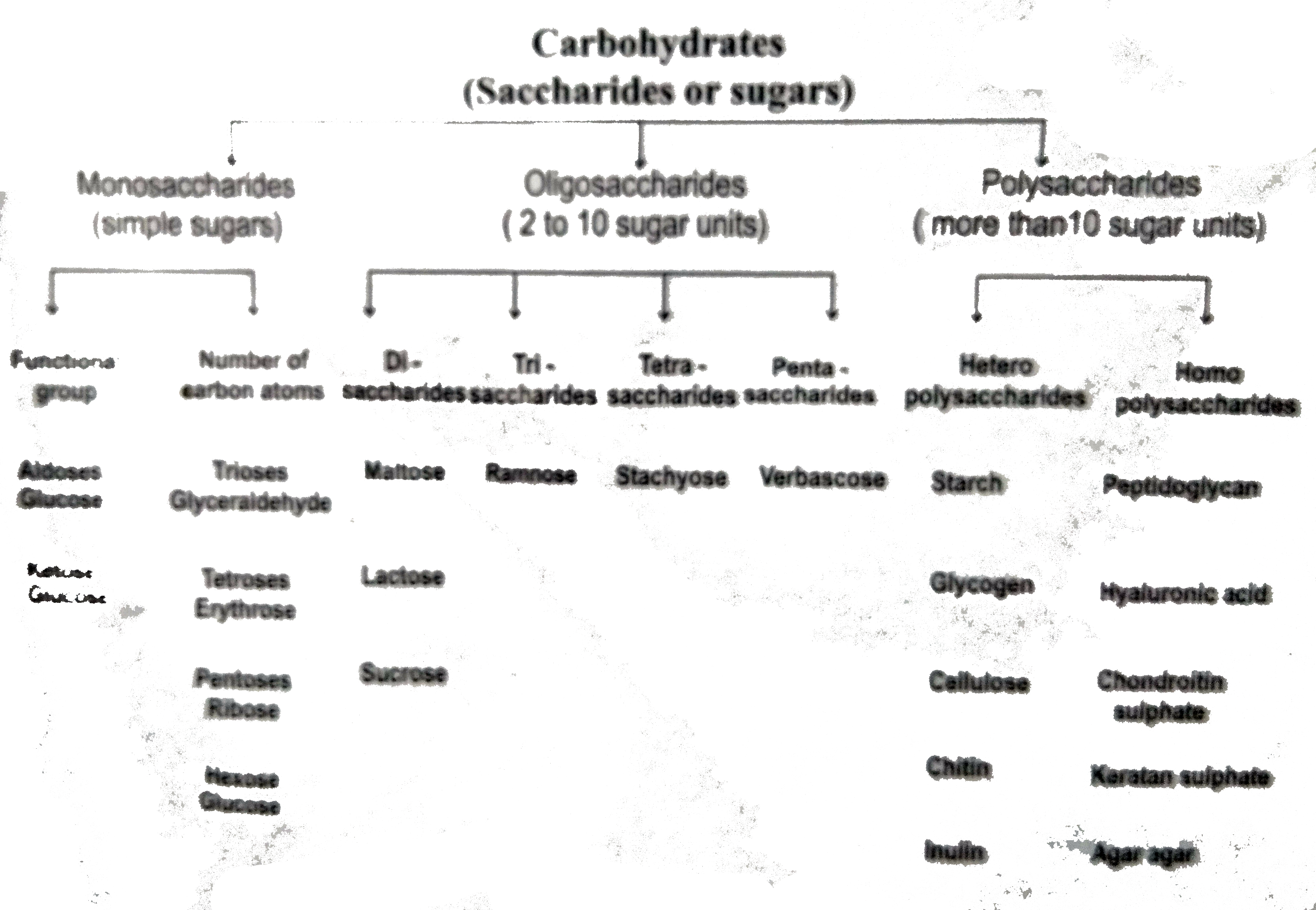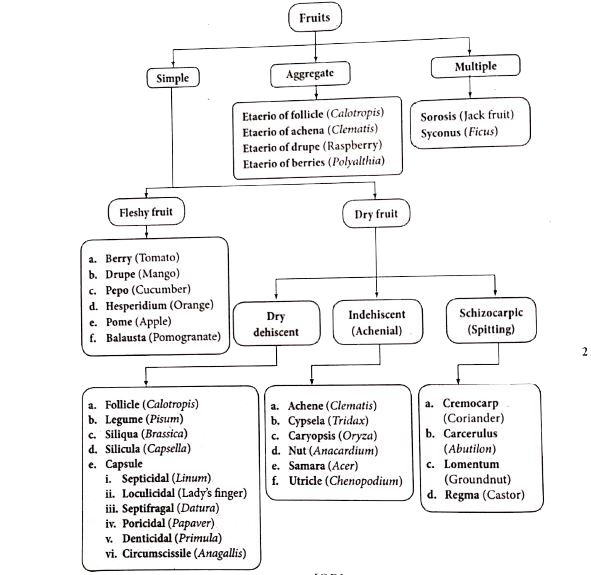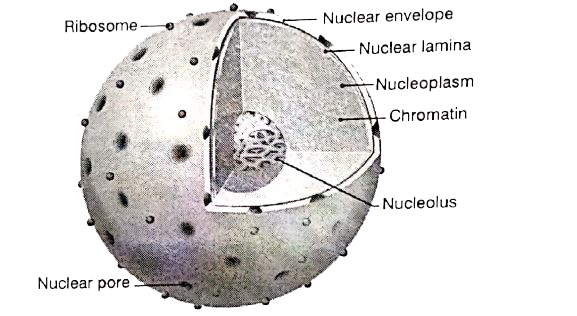InterviewSolution
This section includes InterviewSolutions, each offering curated multiple-choice questions to sharpen your knowledge and support exam preparation. Choose a topic below to get started.
| 17751. |
Question : Draw a Flow Chart depicting the Carbohydrate Classification. |
Answer» SOLUTION :
|
|
| 17752. |
Question : Explain the Calvin Cycle (Flow chart only). |
Answer» SOLUTION :
|
|
| 17753. |
Question : Draw a flow chart depicting the classification of fruits. |
Answer» Solution : Nucleus is an important unit of cell which control all activities of the cell. Nucleus holds the hereditary information. It is the largest among all organelles. It may be spherical, cuboidal, ellipsoidal or discoidal. It is surroundel by a double membrane structure called NUCLEAR evelope, which has the inner and outer membrane. the inner membrane is smooth without ribosomes with irregular and ifrequent intervals with the endoplasmic reticulum. The membrane is perforated by pores known as nuclear pores which allows materials such as mRNA, ribosomal units, proteins and other macromolecules to pass in and out of the nucleus. The pores enclosed by circular structures called annuli. the pore and annuli FORMS the pore complex. the space between two menbranes is called perinuclear space. Nuclear space is filled with nucleoplasm, a gelatinous matrix has uncondensed chromatin network and a CONSPICUOUS nucleoli. the chromatin network is the uncoiled, indistinct and remain thread like during the interphase. It has little amount of RNA and DNA bound to histone proteins in eukaryotic cells. 
|
|
| 17755. |
Question : Draw a diagramatic representation of steward scheme of stomatal movement. |
|
Answer» SOLUTION : 
|
|
| 17756. |
Question : Draw a diagram showing the various components of enzymes. |
Answer» SOLUTION :CATALYTIC SITE, COFACTOR and HOLOENZYME. 
|
|
| 17758. |
Question : Dr. Salim Ali is a famous |
|
Answer» entomologist |
|
| 17759. |
Question : DPD of pure water is zero. |
|
Answer» True |
|
| 17761. |
Question : DPD in thermodynamic terminology is known as ................................ |
| Answer» SOLUTION :WATER POTENTIAL | |
| 17762. |
Question : DPD always has a positive value whereas water potential a negative value |
|
Answer» |
|
| 17764. |
Question : Double membrane pleural sac |
|
Answer» ENVELOPS the kidneys |
|
| 17765. |
Question : Double fertilization is exhibited by : |
|
Answer» GYMNOSPERMS |
|
| 17766. |
Question : Double fertilization is present is angiosperms . |
| Answer» SOLUTION :Out of TWO male GAMETES ONE gamete fuses with egg to form zygote and second male gamete fuses with secondary nucleus to form primary ENDOSPERM nucleus . | |
| 17767. |
Question : Double fertilization involves |
|
Answer» FERTILIZATION of the EGG by two male gametes |
|
| 17768. |
Question : Double fertilization in an angiosperm produces a : |
|
Answer» diploid ZYGOTE and a diploid ENDOSPERM |
|
| 17769. |
Question : Double fertilization |
|
Answer» GYMNOSPERMS |
|
| 17770. |
Question : Dorsal root ganglion , preganglionic sympathetic neuron , lateral chain ganglia , postganglionic sympathetic neuron |
|
Answer» |
|
| 17771. |
Question : Door-window of house swell in monsoon. |
| Answer» SOLUTION :Because any colloid system ABSORBS water from its surroundings in large amount and SWELL. WOOD absorbs moisture from the surroundings in monsoon thus due to imbibition door and window of house absorb moisture and swell. | |
| 17772. |
Question : Donnan's membrane is the |
|
Answer» Respiratory MEMBRANE |
|
| 17773. |
Question : What is Donnan equilibrium. |
|
Answer» Solution :WITHIN the cell, some of the ions never DIFFUSE outthrough the membrane. They are trapped within the cell and are called fixed ions. But they must be balanced by the ions of OPPOSITE CHARGE. Assuming that a CONCENTRATION of fixed anions is present inside the membrane, more cations would be absorbed in addition to the normal exchange to maintain the equibrane. Therefore, the cation concentration would be greater in the internal than in the external solution. This electrical balance or equilibrium controlled by electrical as well as diffusion phenomenon is known as the Donnan equilibrium. |
|
| 17774. |
Question : Dominant stage in bryophytes is |
|
Answer» Independent sporophyte |
|
| 17775. |
Question : Dominant Sea Weeds belong to |
|
Answer» CHLOROPHYCEAE and Charophyceae |
|
| 17776. |
Question : Domesticated ducks have been derived from the wild duck named ............. |
| Answer» SOLUTION :ANAS boscas/Mallard | |
| 17777. |
Question : “Dolipore septum" is the characteristic of |
|
Answer» MYXOMYCETES |
|
| 17778. |
Question : Does the photosynthesis occur in moon light ? Why ? |
| Answer» SOLUTION :No, the MOONLIGHT is unable to perform light reactions of photosynthesis (ATP-NADPH Synthesis as it is 1/50,000 the intensity of sunlight and not strong enough to enable plants to photsynthesise. SHORT | |
| 17779. |
Question : Does the growth pattern in plants differ from that in animals? Do all the parts of plant grow indefinitely? If not, name the regions of plant, which can grow indefinitely. |
|
Answer» Solution :Yes, the growth pattern in plants DIFFER from that in animals. Plant growth is unique because plants retain the capacity for unlimited growth throughout their life. This ability of the plants is DUE to the presence of meristems at certain locations in their body. The cells of such meristems have the capacity to divide and selfperpetuate. The product, however soon LOSES the capacity to divide and such cells make up the plant body. This FORM of growth wherein new cells are always being added to the plant body by the activity of the meristem is called the open form of growth. Growth in animals : They have limited growth PERIOD after which further growth of their body stops. |
|
| 17780. |
Question : Does resting phase of the cell cycle signify that there is no activity going inside the cell? Justify your answer . |
|
Answer» Solution :Resting phase is `G_(0)` phase : Some cells exit `G_(1)` and ENTERS a quiescent stage CALLED `G_(0)` , where the cells remain metabolically active WITHOUT proliferation . Cells can exist for long periods in `G_(0) ` phase . In `G_(0)` cells cease growth with reduced rate of RNA and protein SYNTHESIS. |
|
| 17781. |
Question : Does moonlight support photosynthesis ? Find out. |
| Answer» SOLUTION :PLANTS cannot perform photo SYNTHESIS in MOON light because tha light - doesn.t have enough energy to STIMULATE chlorophyll. Means nolight based processes occur in PS-I and PS-II so photosynthesis does not occur in moonlight. | |
| 17782. |
Question : Does gall bladder form bile ? |
| Answer» Solution :Gall bladder is not ASSOCIATED with formation of bile. It stores bile which is SECRETED by cells of LIVER. | |
| 17783. |
Question : Does dark reaction occur at night in the leaves? |
| Answer» SOLUTION :No. It OCCURS during the day time but does not REQUIRE LIGHT. | |
| 17784. |
Question : Does absorption spectrum has any corelation to the action spectrum? |
| Answer» SOLUTION :YES, there is a DIRECT CORELATION. | |
| 17785. |
Question :Doctors use stethoscope to hear the sound, produced during each cardiac cycle. The second sound is heard when: |
|
Answer» AV node receives SIGNAL from SA node |
|
| 17786. |
Question : Do your know any step in the TCA cyclewherethere is substrate levelphosphorylation.Whichone ? |
|
Answer» SOLUTION :WhenSuccinileCoA GETS CONVERTED into succinic acid, one MOLECULE of GTPis formed in STROMA basedphosphorylation. `GTP + ADP to GDP + ATP ` 
|
|
| 17787. |
Question : Do you know your lower limb segment? Write the 3 segments of lower limb. |
|
Answer» SOLUTION :HINGE joint which is the knee joint GLIDING joint is between the tarsals Ball and socket joint which is between femur and HIP bone Saddle joint is between the TARSAL and metatarsal |
|
| 17788. |
Question : Do you consider a person in coma, living or dead? |
| Answer» SOLUTION :A PERSON lying in coma is not conscious of its surrounding environment such a person is not capable of RESPONDING to the EXTERNAL environmental stimuli. The person is supported by machines for various functions of the body. The person is otherwise braindead. Some of these patients never come back to normal life. They can either be called LIVING nor non-living or dead. | |
| 17789. |
Question : Do you agree with the statement 'Bryophytes need water' for fertilization'? Justify you answer. |
| Answer» Solution :YES, in Bryophytes, WATER plays a VITAL role in fertilisation, since water film is NEEDED for the transfer of spermatium (male sex cell) to the egg cell. | |
| 17790. |
Question : Do you agree that virus is living organism ? If you say yes, justify your answer. |
|
Answer» Solution :Yes. VIRUSES have the characters of living organisms because `{:("They possess nucleic acid and PROTEIN","Capable of mutation"),("Ability to multiply inside a living cell","SHOW irritability"),("Ability to inject and cause disease","Hosts SPECIFIC"):}` |
|
| 17791. |
Question : Do seeds planted upside down germinate? |
|
Answer» Solution :1. A seed will greminate whether it is sown upside down or in the right POSITION. 2. It has the ability to position itself with stem growing upward and root growing downward. 3. The GROWTH hormones RESPOND to gravity and rotate the seed in the right direction. Some ENERGY loss would occur in such SHIFTING of position. |
|
| 17792. |
Question : Do reactions of photosynthesis called, as 'Dark Reaction' need light ? Explain. |
| Answer» Solution :Dark reaction is a reaction free from light `CO_(2)` get reduced by various processes and forms GLUCOSE for that LIGH is not NEEDED. But this process is dependent on products of light reaction like `NAD PH_(2)` & ATP. | |
| 17793. |
Question : Do plants breathe ? |
|
Answer» SOLUTION :PLANTS do not breathe but RESPIRE . Plants need `O_(2)` for RESPIRATION and they give out `CO_(2)` Hence, plantshave systems in place that ensures the availability of `O_(2)`. Plants unlikeanimals have no specialised organs or gaseous exchange. They have stomata and lenticles for this purpose. |
|
| 17794. |
Question :Do different species of plants growing in the same soil show the same rateof transpiration at a particular time ? Justify your answer. |
| Answer» Solution : RATE of TRANSPIRATION is not same because transpiration is affected by NUMBERSAND DISTRIBUTION of stomata, and their OPENING. | |
| 17795. |
Question : Do different species of plant a growing in the same area show the same rate of transpiration at a particular time ? Justify your answer. |
|
Answer» SOLUTION :The RATE of transpiration is dependent on various FACTORS. The two PLANTS having some external structure and related to it their external factors AFFECT the rate of transpiration. Like wind humidity, temperature and intensity of light etc. |
|
| 17796. |
Question : DNAwhichis composedofdinucleotide unitis |
|
Answer» A-DNA |
|
| 17798. |
Question : DNA replication in bacteria occurs : |
|
Answer» During S PHASE |
|
| 17799. |
Question : DNA of mitochondrion is ____ |
|
Answer» Helical |
|
| 17800. |
Question : DNA is present in |
|
Answer» CHROMOSOME and dictyosome |
|